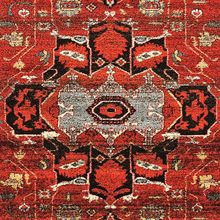Goravan Rug
Revision as of 11:29, 4 December 2019 by Niloufar Alipour (talk | contribs)
| Goravan Rug | |
|---|---|
 Design of Goravan Rug (Rugman) | |
| General information | |
| Name | Goravan Rug |
| Original name | قالی گراوان |
| Alternative name(s) | Goravan Carpet |
| Origin | |
| Category | Village |
| Technical information | |
| Common designs | Lachak Toranj, Geometric |
| Common motifs & patterns | Like to Heriz Rug and Tabriz Rug |
| Common colors | Blue, Red, Beige |
| Dyeing method | Natural, Synthetic |
| Pile material | Wool |
| Foundation material | Cotton |
| Knot type | Symmetrical (Turkish) |
Goravan rugs originate from Goravan, a small village in northwestern Iran, in close proximity to Heriz. The design, color, and quality of a Persian carpet from Goravan is so entirely identical to a Persian carpet from Heriz, that even experts in the field have great difficulty telling them apart. Although Heriz is the better known area, a Persian carpet woven in Goravan is every bit its equal. Typically, Goravan rugs are woven with a special Turkish symmetrical double knot that is dense and tightly packed, although occasionally the asymmetrical Persian knot is used.
History
Materials
Foundation and Pile
Techniques and structures
Color and dyeing
Motifs and Designs
Weaving techniques
See also
References
Bibliography
- Abraham Levi Moheban, (2015), The Encyclopedia of Antique Carpets: Twenty-Five Centuries of Weaving, NewYork: Princeton Architectural Press.